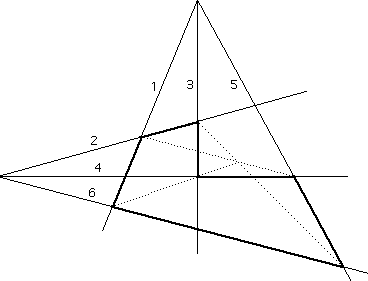 representing the element to see that this element has order 2.
representing the element to see that this element has order 2.
A point x is a fixed point if x = (ax + b)/(cx - a) ⇒ cx2 - 2ax - b = 0 ⇒ x = [a ±  (a2 + bc)]/c and thus f has two fixed points equidistant from a/c = f(∞).
(a2 + bc)]/c and thus f has two fixed points equidistant from a/c = f(∞).
Since f preserves cross-ratios (p , q ; x , f(x)) = (f(p) , f(q) ; f(x) , f2(x)) = (p , q ; f(x) , x) since p, q are fixed and f2 = id.
if γ = (a , b ; c , d) = (a , b ; d , c) then (d - b)/(d - a).(c - a)/(c - b) = (c - b)/(c - a).(d - a)/(d - b) ⇒ γ2 = 1 ⇒ γ = ±1 and since x ≠ p, q we have γ ≠ 1. Hence γ = -1.

Choose any point not on the first line l and join it to the first three points. Put in the second line m and adjust it so that two of the points are on the correct line. Then tilt it until the third point lies on the correct line.
In fact the converse of this result is true: any map from RP1 to RP1 given by projection from a point not on either line does give an element of PGL(2, R).
 maps the three given points to a, b and c.
maps the three given points to a, b and c.
To map [1, 1, 1] to the fourth point means solving the equations a1/α + b1/β + c1/γ = 1, etc for 1/α, 1/β and 1/γ and we can do this since the matrix of coefficients is non singular (otherwise a, b and c would be on a line).
Then, as in the case of RP1, if θ maps these four standard points to a, b, c and d and φ maps them to a', b', c' and d' then the map we need is φ ∘ θ-1.
Then conjugate this map by a map which maps a, b, c to ∞, 0, 1.
The matrix  has a unique eigenvector which represents the point at ∞. On the affine line the translationn Ta is x ↦ (1x + a)/1 = x + a and so is a translation.
has a unique eigenvector which represents the point at ∞. On the affine line the translationn Ta is x ↦ (1x + a)/1 = x + a and so is a translation.
If g is any projective map with a unique fixed point p, let h be a map which sends p to ∞. Then h-1∘g∘h has ∞ as a unique fixed point and so is a translation.

Project P and Q to points on the line at infinity. This then gives a diagram:
Then 12 ‖ 54 and 23 ‖ 65 and we need to show that 16 ‖ 34.
To show this, prove that Δ016 and Δ034 are similar.
To do this note that (by similar triangles) 01 : 05 = 02 : 04 and 03 : 05 = 02 : 06
So 01 . 04 = 02 . 05 = 03 . 06 and so 01 : 03 = 06 : 04 which is what we need.
 The dual of Pappus's theorem is:
The dual of Pappus's theorem is:
If the alternate sides of a hexagon pass through two points then the joins of opposite vertices are concurrent.
The diagram on the right illustrates this.